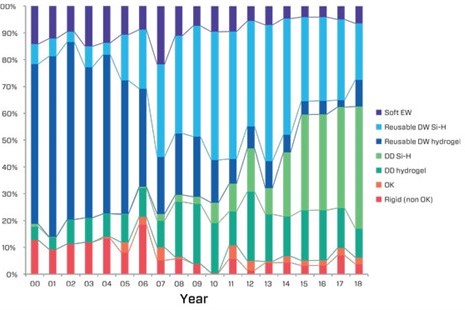2018 contact lens prescribing trends
The 19th annual survey of Australian contact lens prescribing, conducted by Optometry Australia (OA) between January and April 2018, shows an increase in the average age of lens wearers and a high rate of prescribing daily disposable lenses in Australia. As the material of choice, silicone hydrogels represent around 78% of all soft lens fits.
Study results, based largely on new lens fit data collected via simple questionnaires sent to member optometrists by OA, also show high levels of contact lens fitting for presbyopia (especially multifocals) and astigmatism, continue at similarly high levels as have been observed since the turn of the century.

Figure 2. Proportion of all fits of various lens categories in Australia between 2000 and 2018 (EW, extended wear; DW, daily wear; Si-H, silicone hydrogel; DD, daily disposable; OK, orthokeratology). Images courtesy Optometry Australia.
The survey shows the average age of contact lens wearers at the time of fitting was 40.2 ± 16.9 years, the first time that the average age at fitting in Australia has exceeded 40 years, and up from 32 in 2000. It also reflects a strong preference for soft contact lenses, which account for 87% of new fits although this figure is slightly lower than for the past two years. Almost a quarter of soft contact lenses are toric.
For Optometry Australia’s full blog about the report see http://www.optometry.org.au/blog-news/2018/12/3/contact-lens-prescribing-trends-2018/.



























